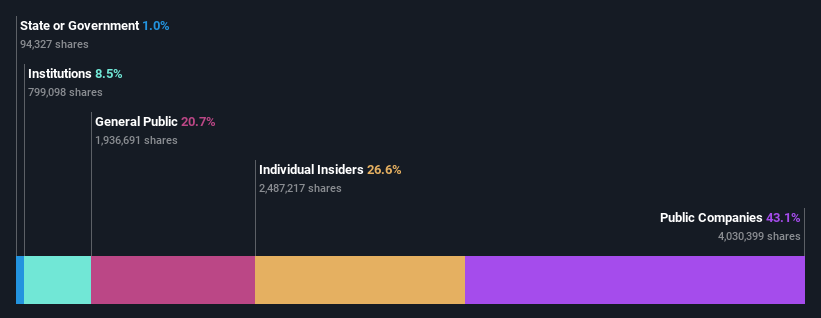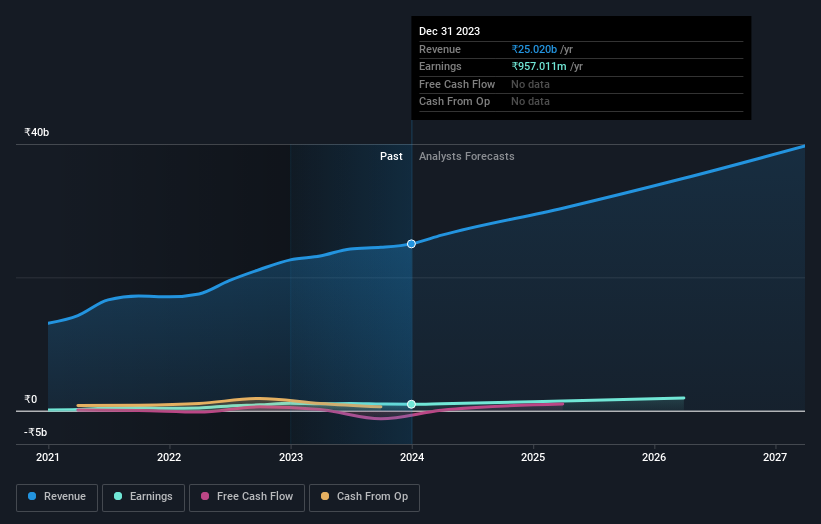- India
- /
- Auto Components
- /
- NSEI:LUMAXIND
Lumax Industries Limited (NSE:LUMAXIND) surges 10%; public companies who own 43% shares profited along with insiders
Key Insights
- Significant control over Lumax Industries by public companies implies that the general public has more power to influence management and governance-related decisions
- A total of 3 investors have a majority stake in the company with 62% ownership
- Insider ownership in Lumax Industries is 27%
Every investor in Lumax Industries Limited (NSE:LUMAXIND) should be aware of the most powerful shareholder groups. We can see that public companies own the lion's share in the company with 43% ownership. Put another way, the group faces the maximum upside potential (or downside risk).
While public companies were the group that benefitted the most from last week’s ₹2.4b market cap gain, insiders too had a 27% share in those profits.
In the chart below, we zoom in on the different ownership groups of Lumax Industries.
Check out our latest analysis for Lumax Industries

What Does The Institutional Ownership Tell Us About Lumax Industries?
Institutional investors commonly compare their own returns to the returns of a commonly followed index. So they generally do consider buying larger companies that are included in the relevant benchmark index.
We can see that Lumax Industries does have institutional investors; and they hold a good portion of the company's stock. This can indicate that the company has a certain degree of credibility in the investment community. However, it is best to be wary of relying on the supposed validation that comes with institutional investors. They too, get it wrong sometimes. It is not uncommon to see a big share price drop if two large institutional investors try to sell out of a stock at the same time. So it is worth checking the past earnings trajectory of Lumax Industries, (below). Of course, keep in mind that there are other factors to consider, too.

We note that hedge funds don't have a meaningful investment in Lumax Industries. Looking at our data, we can see that the largest shareholder is Stanley Electric Co., Ltd. with 36% of shares outstanding. The second and third largest shareholders are Deepak Jain and Anmol Jain, with an equal amount of shares to their name at 13%. Interestingly, the bottom two of the top three shareholders also hold the title of Top Key Executive and Member of the Board of Directors, respectively, suggesting that these insiders have a personal stake in the company.
A more detailed study of the shareholder registry showed us that 3 of the top shareholders have a considerable amount of ownership in the company, via their 62% stake.
While studying institutional ownership for a company can add value to your research, it is also a good practice to research analyst recommendations to get a deeper understand of a stock's expected performance. There are a reasonable number of analysts covering the stock, so it might be useful to find out their aggregate view on the future.
Insider Ownership Of Lumax Industries
The definition of company insiders can be subjective and does vary between jurisdictions. Our data reflects individual insiders, capturing board members at the very least. Company management run the business, but the CEO will answer to the board, even if he or she is a member of it.
Most consider insider ownership a positive because it can indicate the board is well aligned with other shareholders. However, on some occasions too much power is concentrated within this group.
It seems insiders own a significant proportion of Lumax Industries Limited. Insiders have a ₹6.9b stake in this ₹26b business. It is great to see insiders so invested in the business. It might be worth checking if those insiders have been buying recently.
General Public Ownership
The general public-- including retail investors -- own 21% stake in the company, and hence can't easily be ignored. This size of ownership, while considerable, may not be enough to change company policy if the decision is not in sync with other large shareholders.
Public Company Ownership
We can see that public companies hold 43% of the Lumax Industries shares on issue. This may be a strategic interest and the two companies may have related business interests. It could be that they have de-merged. This holding is probably worth investigating further.
Next Steps:
I find it very interesting to look at who exactly owns a company. But to truly gain insight, we need to consider other information, too. Be aware that Lumax Industries is showing 2 warning signs in our investment analysis , and 1 of those is a bit concerning...
If you would prefer discover what analysts are predicting in terms of future growth, do not miss this free report on analyst forecasts.
NB: Figures in this article are calculated using data from the last twelve months, which refer to the 12-month period ending on the last date of the month the financial statement is dated. This may not be consistent with full year annual report figures.
New: AI Stock Screener & Alerts
Our new AI Stock Screener scans the market every day to uncover opportunities.
• Dividend Powerhouses (3%+ Yield)
• Undervalued Small Caps with Insider Buying
• High growth Tech and AI Companies
Or build your own from over 50 metrics.
Have feedback on this article? Concerned about the content? Get in touch with us directly. Alternatively, email editorial-team (at) simplywallst.com.
This article by Simply Wall St is general in nature. We provide commentary based on historical data and analyst forecasts only using an unbiased methodology and our articles are not intended to be financial advice. It does not constitute a recommendation to buy or sell any stock, and does not take account of your objectives, or your financial situation. We aim to bring you long-term focused analysis driven by fundamental data. Note that our analysis may not factor in the latest price-sensitive company announcements or qualitative material. Simply Wall St has no position in any stocks mentioned.
About NSEI:LUMAXIND
Lumax Industries
Manufactures and sells automotive components for in India.
High growth potential with acceptable track record.
Market Insights
Community Narratives




